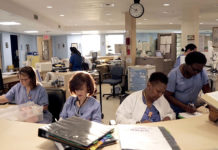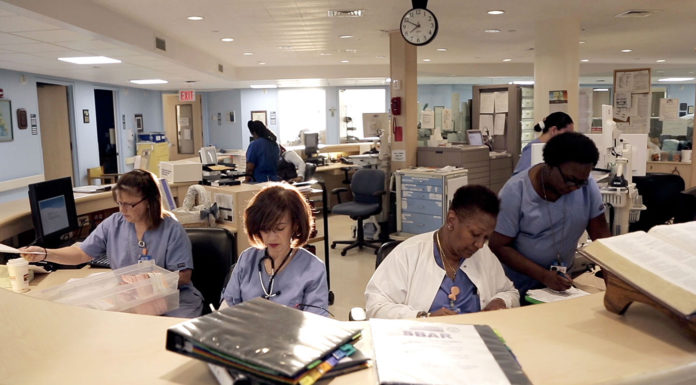Every person at some point in their life or death will be moved by somebody else, says moving and handling consultant Anne McMahon. The trick is doing it safely.
“We need to make sure that that event is safe, dignified and appropriate,” says the nurse who is also the chair of the Moving and Handling Association of New Zealand (MHANZ).
Getting it right optimises the therapeutic potential of moving the patient and reduces the risk of falls and pressure injuries. Getting it wrong, however, may be life-altering and career-ending for a healthcare worker.
Statistics from ACC indicate that too often the health sector is getting the moving and handling of patients wrong. In 2015 there were 494 new patient manual handling injury claims by healthcare workers in the acute hospital sector and 868 in the residential aged care sector. The cost to ACC in 2015 of the new and ongoing patient handling claims by healthcare workers was $3.3 million.
On top of that is the personal cost – financial, physical and emotional – to the injured healthcare worker and their family. Then there are the flow-on effects on wards and rest homes when healthcare workers’ injuries and pain lead to absenteeism, burnout, staff turnover and early retirement.
When all the ingredients for a good moving and handling culture are absent, the risk of a patient falling can also increase; a 2012 report suggested that inpatient falls may cost New Zealand hospitals around $5 million a year.
Not being repositioned regularly also puts patients at a higher risk of pressure injuries and the 2015 KPMG report into pressure injury (PI) reduction estimates that PIs cost the country $690 million every year.
McMahon says it is no coincidence that one of the countries with the best record in reducing pressure injuries – the Netherlands – also has one of the best moving and handling programmes in the world.
After specialising in moving and handling for more than a decade, McMahon says one of the key differences between New Zealand and countries like the Netherlands and the UK is regulations that help to embed moving and handling programmes into the health sector.
In New Zealand there are no dedicated regulations, but there are extensive guidelines published by ACC with the most recent version – Moving and Handling People: The New Zealand Guidelines 2012 – being co-edited by McMahon. (Note ACC is currently updating the guidelines in league with Worksafe.)
The need for good moving and handling strategies keeps growing as patients in our hospitals and residential aged care sector get sicker, older and larger. Clients are also being discharged earlier from hospital and staying at home longer, creating the need for greater moving and handling support in the community.
So what do you need to reduce the risk to nurses and other healthcare workers of being injured by handling the people they care for? And at the same time reduce the risk of patients falling or sustaining pressure injuries because of moving and mobility issues?
Training an essential
You can’t have safe patients unless you’ve got safe staff and vice versa, says McMahon. The aim when moving patients is to maximise their function – as well as their independence and dignity – while minimising the risk to both parties.
The ACC guidelines include having buy-in from senior management, the right equipment, ongoing staff training, the right assessment protocols and adequate space. Not forgetting a culture of safety where the “way things are done around here” is the safe way.
McMahon has put theory into practice by developing and implementing a comprehensive moving and handling programme for her employer, Waitemata District Health Board. She says the integrated policy has made a “significant difference” to the dollar cost of injuries and has led to a “huge culture change”.
That culture change began when McMahon decided to rewrite the moving and handling training programme soon after becoming the DHB’s moving and handling coordinator in 2005. She decided the ‘train the trainer’-type model wasn’t adequate, wrote the strategy and approached ACC to fund a pilot strategy in 2006.
The pilot was successful and remains the DHB’s current model with five levels of training. Two of these are mandatory and involve one-day day moving and handling training for new staff, followed up by an annual training session. That basic training is also supported by area, patient and task-specific training where needed, e.g. proning in ICU.
A major focus of the training is communication. McMahon says the importance of this was brought home to her following a patient satisfaction study designed and delivered by her team. The semi-qualitative study interviewed 65 WDHB patients and showed several outcomes from the patients’ perspective, including 100% satisfaction in being moved with equipment.
A surprising outcome was the slight increase in anxiety for patients being moved with slide sheets rather than hoisting. McMahon says this is possibly because hoisting is a process where staff have to actively engage and communicate with patients, whereas moving patients with slide sheets can often become a secondary task and nurses can end up talking over the patient rather than to them.
She adds that the moving and handling team don’t introduce any new techniques or equipment unless they have tested it on each other and are happy that it is an improvement.
Ceiling hoists and culture
A good moving and handling programme also requires the right equipment and the right infrastructure.
“We can have the best training in the world but if the individual goes back to an area where the space is too small to use the equipment, well, it is pointless,” says McMahon. She says while bed technology has evolved, the space around the bed has not grown to match the amount of equipment and people needed for bedside care of today’s high acuity patients.
McMahon believes ceiling hoists should be considered standard rather than gold standard, with international research indicating that the cost of investing in ceiling tracking and hoists can be recouped in three years through the reduction in injury costs.
When it comes to the purchasing and upgrading of equipment like beds and hoists, McMahon believes this is best done centrally to prevent individual departments having to lobby for funding. While the equipment is purchased centrally, it needs to be safely stored closely to hand – preferably within 20m of handling areas and within 10m of nurse stations.
Having the right equipment, training and environment are all part of building a culture of safety for moving and handling but the ACC guidelines point out that psychosocial factors and work climate are also important components.
“Negative work climate factors, such as working irregular or long shifts and having inadequate sleep owing to long working hours, are associated with musculoskeletal problems including back pain, back injury and sick leave among healthcare staff,” says the ACC publication.
It adds that negative outcomes are more prevalent when workers feel they have little control over their work and perceive their work environment as unsupportive. Psychosocial factors affecting health care workers include the type and length of work shifts, fatigue, physical and verbal abuse from clients, family members or other staff, and the type of carer role.
The MHANZ chair agrees and says most staff who don’t follow good moving and handling practices don’t do so because ‘they can’t be bothered’ but instead because either they don’t know how or perceive there just isn’t the time or resource to be able to do it.
“I do believe the pressure on nurses at the moment is unlike it has ever been,” says McMahon. At the same time, the average nurse is getting older and their patients are becoming older, heavier and higher acuity.
Employers’ obligations
April last year saw the Health and Safety at Work Act come into force, placing greater responsibility on employers to manage risks to their staff.
The new legislation puts the onus on employers to eliminate all risks they are ‘reasonably able’ to do and otherwise to do their best to minimise the risk to their workers’ health and safety. For the healthcare sector, suggests the Worksafe website, this would include eliminating manual lifting of patients (except in life-threatening situations) by providing appropriate mechanical aids and equipment, and by training workers to ensure the equipment is used and maintained properly.
Beyond the legal requirements, McMahon says investing in moving and handling programmes makes financial sense as – beyond the injury costs borne by ACC – poor moving and handling also impacts on patient outcomes, sick leave, absenteeism and retention of staff.
Investing in moving and handling should also be seen as an ethical requirement, believes McMahon. Evidence worldwide indicates that injuries and pain are one of the major reasons nurses leave the profession. “As a middle-aged woman you are going to find it very difficult to prove that that degeneration in your spine that comes up on a scan is due to moving and handling and not just your ageing.”
As MHANZ chair, she would like to see employers and professional organisations take leadership in the area so, in particular, moving and handling practice became consistent and regular nationwide – and ideally a requirement for registration and ongoing competence.
She says at present staff training programmes and supporting infrastructure vary widely across the country’s 20
DHBs and the situation is more problematic again for nurses and carers working in the residential aged care and community sector. Her vision is to see district health boards across the country become centres of excellence for their regions and hubs for a national moving and handling programme with consistent training, assessments and auditing so standards could be measured and improved.
“I want to make nurses’ (and other workers’) lives easier, and their working lives longer and more productive, while also making the environment safe for patient care,” says McMahon. “Otherwise we are turning our nurses into patients.”
DEFINITIONS
High-risk client handling tasks
Tasks that have a high risk of musculoskeletal injury for staff performing the tasks. These include – but are not limited to – transferring, lifting, repositioning, bathing patients in bed, making occupied beds, dressing patients, turning patients in bed, and tasks with long durations.
Unsafe manual lifting
Lifting, transferring, repositioning and moving patients using a carer’s body strength without the use of moving and handling equipment or aids to reduce forces on the carer’s musculoskeletal structure.
Source: Moving and Handling People: The New Zealand Guidelines 2012
RESOURCES
MHANZ
Moving and Handling Association of New Zealand
ACC
Moving and Handling People: The New Zealand Guidelines 2012
Internationally peer reviewed.
https://goo.gl/JKAOiR
Royal College of Nursing
Guide to members on correct moving and handling techniques and employer/employee obligations
www.rcn.org.uk/get-help/rcn-advice/moving-and-handling
A Practical Guide to Bariatric Safe Patient Handling and Mobility: Improving Safety and Quality for the Patient of Size
By Susan Gallagher
N.B. MANZ hopes to bring Gallagher to New Zealand for its next road show.
Moving and handling programmes: core components
POLICY: Written policy statement – including patient assessment tools and set techniques for moving clients/patients – that is endorsed and resourced by senior management
TRAINING: Induction training of all health care workers involved in moving people and then annual updates
EQUIPMENT: Providing equipment needed to use the set techniques, for example, ceiling tracking, hoists, mobile hoists, wheeled equipment, slide sheets, etc.
ENVIRONMENT: Providing the right spaces in the facility to allow effective moving and handling, i.e. sufficient space around bed. Renovate/upgrade facilities if needed
CULTURE: Create a culture of safety including recognising that psychosocial factors like irregular/long shifts, inadequate sleep, high workload and staff feeling unsupported are also associated with back injuries/pain and sick leave
Source: adapted from Moving and Handling People: The New Zealand Guidelines 2012



















